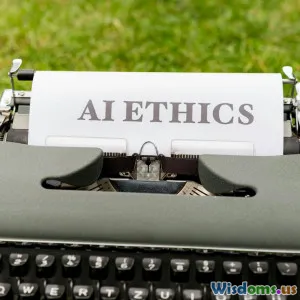
AI Ethics in Automation
8 min read Explore ethical challenges in AI-driven automation and how responsible practices shape a fair and transparent digital future. (0 Reviews)
AI Ethics in Automation: Navigating the Moral Compass of Intelligent Machines
In today’s world where technological breakthroughs are unfolding rapidly, automation powered by Artificial Intelligence (AI) is transforming industries, economies, and daily life. From self-driving cars navigating city streets to algorithms managing hiring decisions, AI automates complex tasks with remarkable efficiency. Yet with these advancements come profound ethical questions: How do we ensure machines make fair decisions? Can AI be held accountable for errors? What happens to human dignity and employment in an automated future?
This article explores the critical domain of AI ethics in automation — a topic that challenges developers, policymakers, businesses, and society alike to reflect intentionally on how AI impacts our lives beyond pure performance metrics.
Understanding the Intersection of AI and Automation
Automation unleashes machines to perform tasks previously done by humans. Incorporating AI means these machines can "think," adapt, and make decisions based on data patterns. Examples include:
- Industrial robots that recalibrate themselves to optimize assembly lines.
- AI-powered recruitment tools analyzing resumes for candidate screening.
- Smart surveillance systems detecting anomalies through facial recognition.
While productivity soars, these examples raise ethical flags. The algorithms learn from data that often reflect human biases, leading to ethical dilemmas in fairness and justice.
Core Ethical Challenges in AI-Driven Automation
1. Bias and Fairness
Algorithms trained on unrepresentative or flawed data can reinforce social biases. For example, a hiring algorithm trained primarily on male-dominated datasets might sideline qualified female candidates — perpetuating gender inequality. Amazon famously scrapped such a recruiting tool in 2018 after discovering gender bias against women in its automated hiring algorithm.
Ensuring fairness requires:
- Careful dataset curation to reflect diversity.
- Transparent standards for evaluating algorithmic decisions.
- Continuous auditing to detect and correct biases as they emerge.
2. Accountability and Liability
When an autonomous vehicle causes an accident or an AI system makes a wrong medical diagnosis, who is liable? Accountability can blur across developers, deployers, and users.
A landmark example is the fatal crash of an Uber self-driving test car in 2018. The incident raised urgent questions on manufacturer liability, the role of human safety drivers, and regulatory safeguards.
Legal frameworks are still evolving to address such accountability, emphasizing the need for clear responsibilities and standards integrating ethics into design and practice.
3. Transparency and Explainability
AI systems often operate as "black boxes," making decisions via complex, opaque models. Stakeholders—including end users—need to understand how an algorithm arrives at conclusions, especially if outcomes affect rights and livelihoods.
For instance, credit scoring platforms must explain why an applicant is denied a loan. Explainable AI (XAI) techniques strive to make algorithmic processes comprehensible without exposing proprietary secrets or sacrificing accuracy.
4. Social and Economic Impact
Automation inevitably disrupts labor markets. The World Economic Forum predicts that by 2025, automation could displace around 85 million jobs but also create 97 million new ones. Transitioning workers toward new roles demands thoughtful policy support:
- Investing in reskilling and education.
- Developing social safety nets.
- Promoting inclusive job growth in emerging sectors.
Beyond economics, automation influences social dynamics, privacy norms, and human identity, underscoring the need to mitigate harm and promote societal well-being.
Navigating Ethical AI Implementation: Strategies and Innovations
Ethical Frameworks and Standards
Global organizations and governments are crafting AI ethics guidelines. For example, the OECD's AI Principles advocate for inclusive growth, transparency, and human-centered values. Similarly, the EU’s Ethics Guidelines for Trustworthy AI outline requirements such as robustness, privacy, and accountability.
These frameworks provide practical checklists for responsible AI deployment across sectors.
Human-in-the-Loop Models
Integrating humans into AI decision-making cycles ensures oversight and correction capabilities, especially in high-stakes environments like healthcare or criminal justice. This approach balances automation efficiency with human judgment and empathy.
Auditing and Impact Assessments
Regular, independent audits of AI systems can identify ethical risks before widespread scale-up. Impact assessments anticipate consequences on individuals and communities, fostering transparency and stakeholder engagement.
Inclusive and Diverse Teams
Ethical AI initiatives succeed when designed by multidisciplinary, diverse teams that bring varied perspectives to fore, reducing blind spots related to societal norms and bias.
Inspiring Industry Examples
-
Microsoft's AI for Accessibility: Investing over $25 million to empower people with disabilities, ensuring technology uplifts marginalized groups rather than excluding them.
-
IBM’s Watson OpenScale: A platform designed to detect and mitigate bias within AI models in real-time, increasing fairness and explainability.
-
SalesForce’s Ethical Use Directive: Emphasizes guidelines to prevent discrimination and protect privacy in AI-powered CRM tools.
These case studies illustrate how proactive ethics elevate corporate reputation and consumer trust.
Conclusion: Striking a Balance Between Innovation and Responsibility
AI ethics in automation is not merely a technical add-on but a foundational aspect of building trustworthy, sustainable technologies. As automation reshapes our world, embedding ethical principles safeguards human dignity, rights, and societal cohesion.
The journey demands collaboration among engineers, ethicists, regulators, and everyday users. Only by confronting ethical questions head-on can we harness AI’s full potential while mitigating risks — creating an automated future that is equitable, transparent, and accountable.
Your role? Stay informed, advocate for ethical AI practices in your community or workplace, and support policies encouraging responsible innovation. Together, we can steer automation not just toward smarter systems but toward a fairer society.
References:
- World Economic Forum. The Future of Jobs Report 2020.
- Jobin, Anna et al. Worldwide Governance of AI: A Review of Ethics Guidelines. Nature Machine Intelligence, 2019.
- Amazon scrapped AI recruiting tool over bias. Reuters, 2018.
- European Commission. Ethics Guidelines for Trustworthy AI, 2019.
Rate the Post
User Reviews
Popular Posts





















